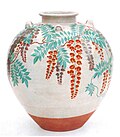Yūri-kinsai
Yūri-kinsai (釉裏金彩) is a gold leaf-application technique used in Japanese pottery and porcelain. It forms a transparent overglaze on gilded porcelain.[1]
Yūri-kinsai is a complicated under look technique. It uses two kinds of gold leaf that consists of one thick and one thin layer. Before firing and glazing the vessel, the leaves are cut or carved into the desired shapes and then applied to the lacquered surface. The leather is then covered in clear glaze and fired at controlled, low temperatures. This firing fuses the leaf to the surface while burning away excess lacquer. In the final stage sometimes two coats of soda glaze are applied to the surface in separate firings. Up to six individual firings are used to achieve the final result.[2] The different thicknesses create the contrast of the pattern and with the glaze giving the vessel a visual dimension.[3]
As well as gold, other noble metals such as silver, in yūri-ginsai (釉裏銀彩), or platinum may be used.[4]
In 2011 it was registered by the government as an Intangible Cultural Property.[5]
Notable artists
[edit]Modern Kutani ware displays refined yūri-kinsai techniques. The Kinzangama kiln was established by the Yoshita family in Komatsu, Ishikawa Prefecture in 1906.[6][7] The third generation master is Minori Yoshita (吉田美統, Yoshita Minori) (b. 1932), who was designated a Living National Treasure for his work.[8]
Hakuko Ono (小野珀子, Ono Hakuko) (1915–1996) was a female artist from Nagoya, who lived and worked in Ureshino, Saga Prefecture. She established herself in the 1970s with porcelain works and became renowned for her yūri-kinsai works.[2] Her son Jiro Ono (小野次郎, Ono Jiro) (1953–2010) continued the tradition, but also specialised in kinrande.[9]
Takuro Furukawa (古川拓郎) (b. 1979), a member of the Japan Kōgei Association, works with a technique called yūri-hakkinnsai (釉裏白金彩), which uses platinum.[10][11]
References
[edit]- ^ "Glazes Menu - EY Net Japanese Pottery Primer". E-yakimono.net. Retrieved 2016-09-05.
- ^ a b "Touch Fire - Japanese Ceramics by Women Artists | Smith College Museum of Art". Smith.edu. Retrieved 2016-09-05.
- ^ "「九谷焼 人間国宝 吉田美統 釉裏金彩」の紹介ページです". Kutani.jp. Retrieved 2016-09-05.
- ^ "夫婦茶碗 銀彩/宗秀窯". Toulife.jp. Retrieved 2016-09-05.
- ^ "釉裏金彩 文化遺産オンライン". Bunka.nii.ac.jp. Retrieved 2016-09-05.
- ^ "Kinzangama Kiln". Horiuchi Foundation. Retrieved 2016-09-05.
- ^ "錦山窯について - 錦山窯 kinzangama". Kinzangama.com. Retrieved 2016-09-05.
- ^ "Yoshita Minori (b. 1932) | ONISHI GALLERY | New York". Onishi Gallery. Retrieved 2016-09-05.
- ^ "Galerie Heller - MainFrame". Galerie-heller.de. 2010-04-18. Retrieved 2016-09-05.
- ^ "Takuro Furukawa". Gallery Japan.
- ^ "Japanese Culture & Style - ARTISAN : "Takuro Furukawa" ceramic artist".


 French
French Deutsch
Deutsch
